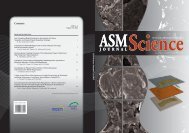contents - Akademi Sains Malaysia
contents - Akademi Sains Malaysia
contents - Akademi Sains Malaysia
- No tags were found...
Create successful ePaper yourself
Turn your PDF publications into a flip-book with our unique Google optimized e-Paper software.
O. Khadijah et al.: Statistical Experimental Designs: Optimization of Medium CompositionTable 7. Theoretical and actual values for percentage decolourisation of PR-MX8B based on the proposed optimised media combinations.Proposed solutions Yeast extract (g/l) Starch (g/l) Corn steep solids (g/l) % DecolourisationPredicted value Actual value aI 4.98 3.11 3.02 51.06 40.11 ± 1.12II 5.00 0.78 2.96 79.00 70.10 ± 2.71III 4.97 2.92 1.75 78.91 69.68 ± 3.55IV 4.99 3.02 2.84 78.47 68.97 ± 1.85V 5.00 2.99 1.89 79.17 72.11 ± 0.50a Note: Results represent an average of three independent experimentsyeast extract (from 0.5 g/l – 5 g/l), there was an increase indye decolourisation. Several studies have reported similarfindings (Chen et al. 2003; Asad et al. 2007) and in additionit was also found that the decolourisation increased onlyslightly in the range of 5 g/l – 10 g/l of yeast extract (Chenet al. 2003).Verification of the ModelThe optimal conditions obtained from the optimizationexperiments were verified experimentally and comparedto those of calculated data from the model. Five out of 10proposed calculated optimal culture compositions for theyeast extract, starch and corn steep solids were selected atrandom and the results are shown in Table 7. In general,the experimental percentage decolourisations were lowerthan those of the predicted values. Those are commonobservations as found by other experimental design studies(El-Sersy 2007; Abdel-Fattah & Olama 2002). The highestestimated percentage decolourisation was 72.11 obtainedfrom the proposed solution V (5.00 g/l yeast extract; 2.99g/l starch; 1.89 g/l corn steep solids) while the predictedvalue from the polynomial model was 79.17%. The resultof the verification experiment revealed a 90.81% degree ofaccuracy for the model.CONCLUSIONThe two-factorial Plackett-Burman design chosen for thestudy allowed the investigation of 14 independent variablesat two different levels. Based on the analysis, three criticalvariables: yeast extract; starch and corn steep solids wereidentified and tested further in the optimisation experiments.In the optimization process, analysis of the Box-Behnkenresults showed that 5.00 g/l yeast extract, 2.99 g/l starchand 1. 89 g/l corn solids were the best combination fortreating PR-MX8B. In conclusion, the result indicated thatthe methodology of Plackett-Burman and Box-Behnkendesigns had proved efficient and the use of these techniqueshad helped to identify the important medium componentswhich had significant effects on dye and textile wastewaterdecolourisation. Further studies are being conducted onapplying the techniques in a bioreactor.ACKNOWLEDGEMENTThe author would like to thank Universiti TeknologiMARA, Shah Alam, Selangor, <strong>Malaysia</strong> for funding theresearch.Date of submission: November 2008Date of acceptance: May 2010ReferencesAbdel-Fattah, YR & Olama, ZA 2002, ‘L-asparaginaseproduction by pseudomonas aeruginosa in solid-stateculture: evaluation and optimization of culture conditionsusing factorial designs’, Process Biochemistry, vol. 38, pp.115–122.Annadurai, G, Sivakumar, T & Babu, SR 2000, ‘Photocatalyticdecolourisation of congo red over ZnO powder using Box-Behnken design of experiments’, Bioprocess Engineering,vol. 23, pp. 167–173.Asad, S, Amoozegar, MA, Pourbabaee, AA, Sarbolouki, MN &Dastgheib, SMM 2007, ‘Decolorization of textile azo dyesby newly isolated halophilic and halotolerant bacteria’,Bioresource Technology, vol. 11, pp. 2082–2088.Assadi, MM, Rostami, K, Shahvali, M & Azin, MA 2001,‘Decolorization of textile wastewater by Phanerochaetechrysosporium’, Desalination, vol. 141, pp. 331–336.Çetin, D & Dönmez, G 2006, ‘Decolorization of reactive dyesby mixed cultures isolated from textile effluent underanaerobic conditions’, Enzyme Microbial Technol. vol. 30,pp. 926–930.Chang, J & Kuo, T 2000, ‘Kinetics of bacterial decolorizationof azo dye with Escherichia coli NO3’, Biores Technology,vol. 75, pp. 107–111.Chang, JS & Lin, YC 2003, ‘Fed batch bioreactor strategies formicrobial decolorization of azo dye using Pseudomonasluteola strain’, Biotechnol Progress, vol. 16, pp. 979–985.Chen, K, Wu, J, Liou, D & Hwang, SJ 2003, ‘Decolorization ofthe textile dyes by newly isolated bacterial strains’, J. ofBiotechnology. vol.101, pp. 57–68.Dong, X, Zhou, J & Ying, L 2003, ‘Peptone-inducedbiodecolourisation of Reactive Brilliant Blue (KN-R) by111paper 1.indd 1111/20/2011 11:14:15 AM

















